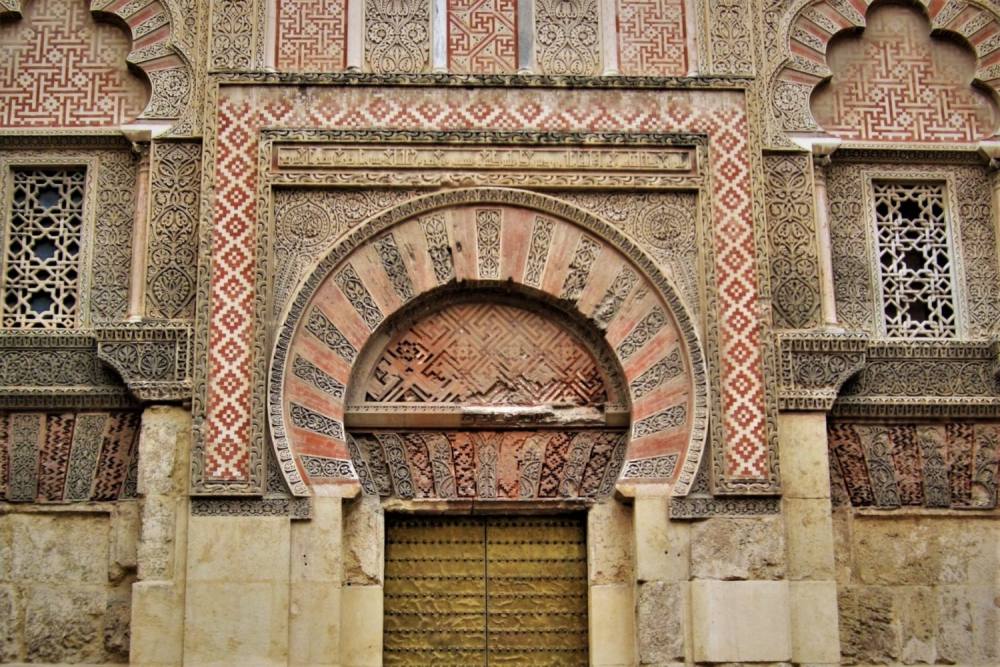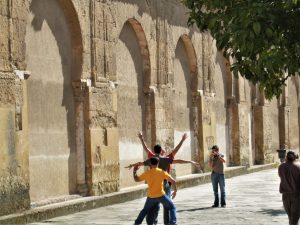- Cordoba was founded by the Romans in 2 BC and became an important provincial base in Hispania under the Emperor Augustus. It was occupied by the Byzantines then by the Visigoths before it was captured by Umayyad Moors in 711. It was under the Moors that the city rose to its greatest prominence.
- In 716 it became capital of the Emirate of Cordoba, subordinate to the Caliphate of Damascus. Internal strife within the Arab Muslim Empire led the Abbasids to defeat the Umayyads in 750. The Umayyads held on to al-Andalus and in 756 Abd al-Rahman I established an independent Emirate of Cordoba. In 929 the Umayyad Emir Abd al-Rahman III declared himself Caliph of Cordoba, and the caliphate he established lasted until 1031 before it crumbled into a number of independent principalities (taifas). The city was recaptured by the Catholic monarch Ferdinand III in 1236.
- We had three nights / four days in Cordoba, including a day trip to Seville. It was a very full and rich experience.
- The historic centre of Cordoba is a World Heritage site. It comprises the Great Mosque (Mezquita) and surrounding areas, the Synagogue and Alcazar, as well as the Roman Bridge and the Torre Calahorra across the River Guadaquivir.
- About 8 kms west is Medina Azahara which Abd al-Rahman III built as a new capital for his Caliphate of Cordoba.
- The Mezquita (Great Mosque) of Cordoba is justifiably famous. Standing in the prayer hall surrounded by a forest of Moorish columns topped with beautiful red and white striped arches is a remarkable experience. Its construction was started by Abd al-Rahman I in 784 and his descendants reworked the building over the next two centuries reaching its current dimensions in 987 with the completion of the outer naves and courtyard. The mihrab supposedly includes 1.6 tonne of gold mosaic cubes gifted by the Byzantne Empire. In its day the building would have been filled with light, but 19 external doors have been bricked up. Even more unfortunately, the centre of the Mezquita was ripped out in the 16th C to allow construction of a Catholic Cathedral which was further decorated during the 17th and 18th C. The fussiness of the Cathedral’s Capilla Mayor offends the elegence of the original structure. To the victors go the rights to spoil…
- It’s pleasant to wander the Mezquita’s courtyard and around its walls. Although most the external doors are bricked up some of the surviving decoration is very beautiful.
- The area around the Mezquita is also World Heritage listed. We visited the Sinagoga (synagogue) and wandered along the lovely Calle de Cairuan which follows the old Islamic walls to the gate of Puerta de Almodovar.
- The Alcazar de los Reyes Cristianos (Castle of the Christian Monarchs) is a palace and fortress commissioned by King Alfonso XI of Castile in 1328, built on the site of earlier Roman, Visigoth, and Moorish buildings. The Alcazar was one of the headquarters of the Spanish Inquisition from 1482 to 1834. It is well worth exploring the towers, courtyards, mosaic room, and baths, and the gardens are delightful.
- The Alcazar is close to the river and we wandered past the Episcopal Palace then across the Roman bridge to the district of Campo de la Verdad-Miraflores. Our visit coincided with the Feria de Mayo (May Fair), a ten day party held in the El Arenal Fairground on the other side of Puenta del Arenal. It was a lot of fun to wander amongst the Cordobans who clearly take their partying seriously. The dresses were colourful, the horses and riders well groomed, and the music absolutely pumping. Of all the fairground rides we liked Mega Kanguro best of all.
- Flamenco originated in Andalucia in the 18th C and remains an important part of local culture. You see van drivers practice their clapping when waiting for traffic lights to change and hear cante flamenco (singing) blare from passing cars. We were interested to see and hear it live. Walking home one evening we were handed a flyer for a small club with a perfromance starting at 22:30. Very Spanish. We went along and had a fabulous time. The club was run by a Gitano (Romani) family and the peformance cycled through instrumental music (acoustic guitar, box drum, clapping, and stomping), male singers, a traditional female dancer, and a younger female dancer with a very different style. The impression it gave is that flamenco is not stuck in time but is evolving through younger generations bringing new skills and perspectives built on very formal traditions. The patriach of the family (José Antonio Plantón Moreno) goes by the stage name of El Calli. We bought an album called Orgullo de Estirpe which translates as something like Proud Lineage. Check it out on Spotify, along with an earlier album called Sonidos con Alma (Sounds of the Soul).
- Abd al-Rahman III was clearly an ambitious man, declaring the Caliphate of Cordoba as rival to the Abissid (Middle East) and Fatimid (Egypt) Caliphates. In 936 he began building a magnificent new capital at Medina Azahara. It was completed by 945 but sacked and looted from around 1010 as the Caliphate of Cordoba fell apart.
- The walled perimeter ran 1.5 kms east to west and 0.75 kms north to south (112 hectares), though only a fraction of the site had been excavated and was open to the public when we visited. Yet it’s one of those sites where there’s just enough left to fire the imagination and we had a fabulous time.
- You enter through the north gate by the Higher Housing, coming to the Ya’far House (of the hayib or Prime Minister) and High Basilical Building. From there you enter the impressive Drawing Room of Abd al-Rahman III. Interestingly, the decorative tracery at Medina Azahara is made from carved limestone rather than the usual material of plaster. The Drawing Room leads onto the Gardens and to the east lie ruins of the Mosque. The tour finishes in the Arms Square which has a lovely Portico along its western edge.
- The site was undergoing further excavation and reconstruction when we visited in 2008. Clearly a lot of work has been done since then as Medina Azahara was inscribed onto the World Heritage list in 2018. We’ll certainly return if we’re in this region again.
![Medina Azahara, higher housing]()
Medina Azahara, higher housing
![towards the Portico and Arms Square]()
towards the Portico and Arms Square
![Portico, from Arms Square]()
Portico, from Arms Square





































